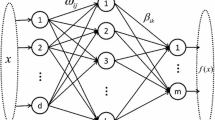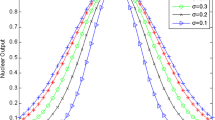Abstract
This paper presents a Hybrid Fuzzy ARTMAP (FAM) and Online Extreme learning machine (OELM), hereafter denoted as FAM-OELM, which enables online learning to start from the first trained data samples without having to set up an initialization phase which requires a chunk of data samples to be ready prior to training. The idea of developing FAM-OELM is motivated by the ELM concept proposed by Huang et al., for being an efficient learning algorithm that provides better generalization performance at a much faster learning speed. However, different from the batch learning ELM and its variant called the online sequential extreme learning machine which still requires an initial offline training phase before it can turn into online training, the proposed FAM-OELM showcases a framework that enable online learning to commence right from the first data sample. Here, classification can be conducted at any time during the training phase. Such appealing feature of the proposed algorithm has strictly fulfilled the criteria of being truly sequential, while many of the existing algorithms are not. In addition, FAM-OELM automatically grows hidden neuron such that the network can accommodate new information without over fitting and compromising on the knowledge learnt earlier. The simulation results reveal the efficacy and validity of FAM-OELM when it is applied to a real world application and various benchmark problems.





Similar content being viewed by others
References
Duda RO, Hart PE, Stork DG (2001) Pattern classification, 2nd edn. Wiley, New York
Moens M-F (2006) Information extraction: algorithms and prospects in a retrieval context, 1st edn. Springer, New York
Isaacs JC, Foo SY, Meyer-Baese A (2007) Novel kernels and kernel PCA for pattern recognition. In: Proceedings of the 2007 IEEE international symposium on computational intelligence in robotics and automation jacksonville, FL, U.S.A., 20–23 June, pp 438–443
Ou G, Murphey YL (2007) Multi-class pattern classification using neural networks. Pattern Recognit 40(1):4–18
Hsu C, Lin C (2002) A comparison of methods for multiclass support vector machines. IEEE Trans Neural Netw 13(2):415–425
Bishop CM (1995) Neural Networks for pattern recognition. Oxford University Press, Oxford
Anand R, Mehrotra K, Mohan CK, ranka S (1995) Efficient classification for multiclass problems using modular neural networks. IEEE Trans Neural Netw 6:117–124
Simpson PK (1992) Fuzzy min-max neural networks-part1: classification. IEEE Trans Neural Netw 3(5):776–786
Huang G-B, Zhu Q-Y, Siew C-K (2006) Extreme learning machine: theory and applications. Neurocomputing 70:489–501
Hornik K (1991) Approximation capabilities of multilayer feedforward networks. Neural Netw 4:251–257
Leshno M, Lin VY, Pinkus A, Schocken S (1993) Multilayer feedforward networks with a nonpolynomial activation function can approximate any function. Neural Netw 6:861–867
Huang GB, Chen Y, Babri HA (2000) Classification ability of a single hidden layer feedforward neural networks. IEEE Trans Neural Netw 11(3):799–801
Huang G-B, Wang DH, Lan Y (2011) Extreme learning machines: a survey. Int J Mach Learn Cybern 2(2):107–122
Liang NY, Huang G-B, Saratchandran P, Sundararajan N (2006) A fast and accurate online sequential learning algorithms for feedforward network. IEEE Trans Neural Netw 17(6):1411–1423
Huang G-B, Zhou H, Ding X, Zhang R (2012) Extreme learning machine for regression and multi-class classification. IEEE Trans Syst Man Cybern Part B Cybern 42(2):513–529
Li G, Liu M, Dong M (2010) A new online learning algorithm for structure-adjustable extreme learning machine. Neurocomput Comput Math Appl 60:377–389
Zhu Q, Qin AK, Suganthan PN, Huang GB (2005) Evolutionary extreme learning machine. Pattern Recognit 38:1759–1763
Chen ZX, Zhu HY, Wang YG (2013) A modified extreme learning machine with sigmoidal activation functions. Neural Comput Appl 22:541–550
Nguyen D, Widrow B (1990) Improving the learning speed of 2-layer neural networks by choosing initial values of the adaptive weights. In: Proceedings of the international joint conference on neural networks IJCNN, San Diego, CA, USA
Javed K, Gouriveau R, Zerhouni N (2014) SW-ELM: a summation wavelet extreme learning machine algorithm with a priori parameter initialization. Neurocomputing 123:299–307
Han F, Yao H-F, Ling Q-H (2013) An improved evolutionary extreme learning machine based on particle swarm optimization. Neurocomputing 116:87–93
Zong W, Huang G-B (2013) Learning to rank with extreme learning machine. Neural Process Lett 39(2):155–166
Wang S-J, Chen H-L, Yan W-J, Chen Y-H, Fu X (2014) Face recognition and micro-expression recognition based on discriminant tensor subspace analysis plus extreme learning machine. Neural Process Lett 39:25–43
Termenon M, Grana M, Barros-Loscertales A, Avila C (2013) Extreme learning machine for feature selection and classification of cocaine dependent patients on structural MRI data. Neural Process Lett 38:375–387
Carpenter GA, Grossberg S, Markuzon N, Reynolds JH, Rosen DB (1992) Fuzzy ARTMAP: a neural network architecture for ncremental supervised learning of analog multidimensional maps. IEEE Trans Neural Netw 3(5):698–713
Tan SC, Rao MVC, Lim CP (2007) A hybrid neural network classifier combining fuzzy ARTMAP and the dynamic decay adjustment algorithm. Soft Comput 12(8):765–775, Springer-Verlag
Yap KS, Lim CP, Abidin IZ (2008) A hybrid ART-GRNN online learning neural network with a \(\varepsilon \)-insensitive loss function. IEEE Trans Neural Netw 19(9):1641–1646
Wang Y, Cao F, Yuan Y (2011) A study on the effectiveness of extreme learning machine. Neurocomputing 74:2483–2490
Blake C, Merz C (1998) UCI repository of machine learning databases, Dept. Inf. Comput. Sci., Univ. California, Irvine, CA, [Online]. Available: http://archive.ics.uci.edu/ml/. Accessed 02 April 2013
Tenaga Nasional Berhad Malaysia (1999) System description and operating procedures prai power station stage 3, 14
Lim CP, Harrison RF (2003) Online pattern classification with multiple neural network systems: an experimental study. IEEE Trans Syst Man Cybern Part C Appl Rev 33(2):235–247
Ankerst M, Ester M, Kriegel HP (2000) Towards an effective cooperation of the user and the computer for classification. In: Proceeding of 6th ACM SIGKDD int. conf. on knowledge discovery & data mining (KDD-2000), pp 179–189
Tan SC, Lim CP (2004) Application of an adaptive neural network with symbolic rule extraction to fault detection and diagnosis an a power generation plant. IEEE Trans Energy Convers 19(2):369–377
Quteishat AMA, Lim CP (2008) A modified fuzzy min-max neural network with rule extraction and its application to fault detection and classification. J Appl Soft Comput 8(2):985–995
Acknowledgments
This work was supported by the University of Malaya Research Collaborative Grant Scheme (PRP-UM-UNITEN), under Grant Number: CG026-2013.
Author information
Authors and Affiliations
Corresponding author
Rights and permissions
About this article
Cite this article
Wong, S.Y., Yap, K.S., Yap, H.J. et al. A Truly Online Learning Algorithm using Hybrid Fuzzy ARTMAP and Online Extreme Learning Machine for Pattern Classification. Neural Process Lett 42, 585–602 (2015). https://doi.org/10.1007/s11063-014-9374-5
Published:
Issue Date:
DOI: https://doi.org/10.1007/s11063-014-9374-5




